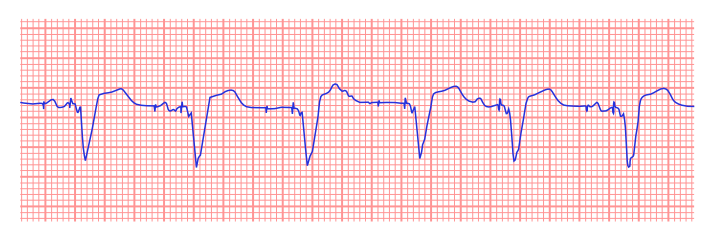

The pacemaker delivers paroxysms of pacing spikes at 200 bpm, which may provoke ventricular fibrillation.This potentially life-threatening malfunction of older-generation pacemakers is related to low battery voltage (e.g.These will also usually terminate with application of a magnet.The ventricular rate cannot exceed the pacemaker’s upper rate limit (usually 160-180 bpm).This misfiring leads to pacing at an inappropriately fast rate.Sensors may “misfire” in the presence of distracting stimuli such as vibrations, loud noises, fever, limb movement, hyperventilation or electrocautery (e.g.Modern pacemakers are programmed to allow increased heart rates in response to physiological stimuli such as exercise, tachypnoea, hypercapnia or acidaemia.May result in rate related ischaemia in the presences of IHD.Newer pacemakers contain programmed algorithms designed to terminate PMT.Can be terminated by slowing AV conduction e.g.Results in a paced tachycardia with the maximum rate limited by the pacemaker programming.The paced ventricular complex results in further retrograde conduction with retrograde p wave generation thus forming a continuous cycle.Caused by retrograde p waves being sensed as native atrial activity with subsequent ventricular pacing.PMT is a re-entry tachycardia in which the pacemaker forms the antegrade pathway with retrograde conduction occurring via the AV node.Also known as endless-loop tachycardia or pacemaker circus movement tachycardia.Several types of pacemaker associated dysrhythmias can occur including pacemaker-mediated tachycardia (PMT), sensor-induced tachycardia, runaway pacemaker, pacemaker-mediated Wenckebach AV block and lead dislodgement dysrhythmia. If the patient’s native heart rate is above the pacemaker threshold, no pacemaker activity is expected and therefore output failure and capture failure cannot be recognised on the ECG. Multiple causes including electrode displacement, wire fracture, electrolyte disturbance, MI or exit block.Failure to capture occurs when paced stimulus does not result in myocardial depolarisation.Multiple causes including oversensing, wire fracture, lead displacement, or interference.Results in decreased or absent pacemaker function.Output failure occurs when a paced stimulus is not generated in a situation where expected.Reduced pacemaker output / output failure may be seen on ECG monitoring if the patient stimulates their rectus or pectoral muscles (due to oversensing of muscle activity).Abnormal signals may not be evident on ECG.These inappropriate signals may be large P or T waves, skeletal muscle activity or lead contact problems.Oversensing occurs when electrical signal are inappropriately recognised as native cardiac activity and pacing is inhibited.ECG findings may be minimal, although presence of pacing spikes within QRS complexes is suggestive of undersensing.Causes include increased stimulation threshold at electrode site (exit block), poor lead contact, new bundle branch block or programming problems.Undersensing occurs when the pacemaker fails to sense native cardiac activity.Note: Normal pacemaker function is discussed extensively in a seperate post. Diagnosis of pacemaker malfunction is challenging and often associated with non-specific clinical symptoms while ECG changes can be subtle or absent.Pacemaker malfunction can occur for a wide variety of reasons, ranging from equipment failure to changes in underlying native rhythm.↪ ECG Library Homepage Pacemaker Malfunction Overview


 0 kommentar(er)
0 kommentar(er)
